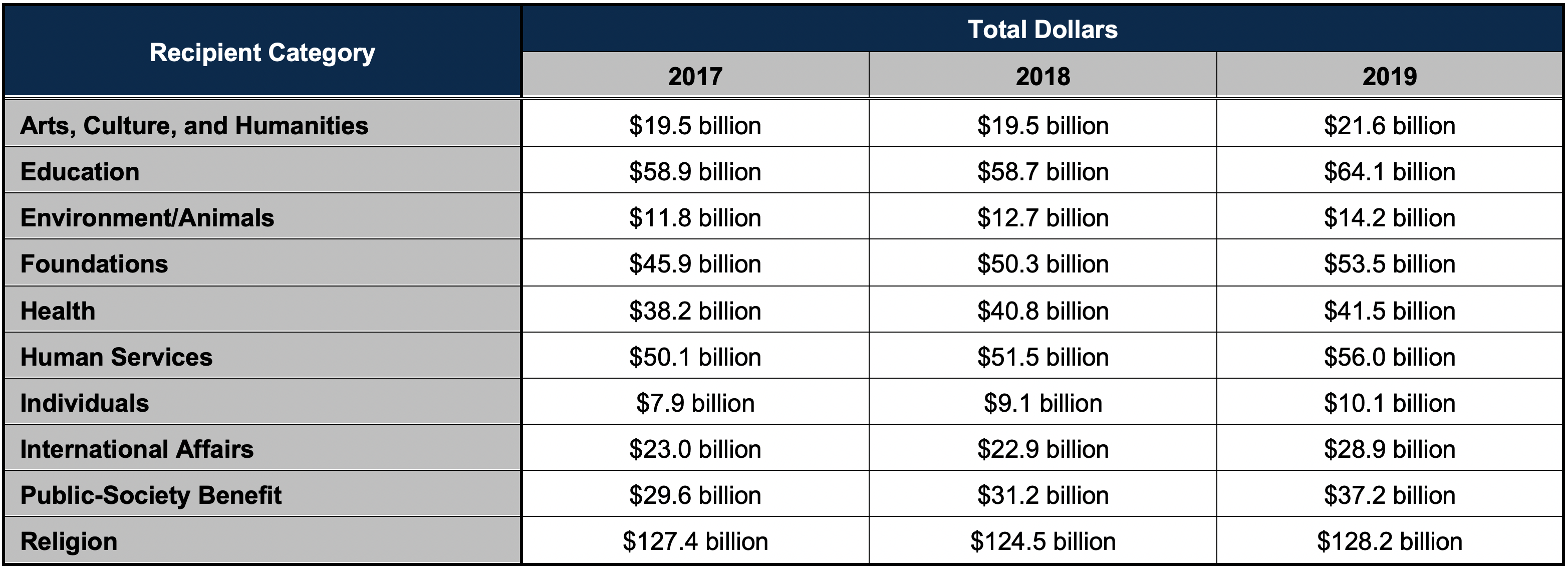Recent Trends in Philanthropic Giving:
An Annual Report on Key Metrics
The close of an organization’s fiscal year provides an excellent opportunity to assess financial performance, including challenges and successes in the fundraising arena. Even during times of crisis, it is critical for arts and culture organizations to conduct a fact-based review of the recent philanthropic climate, regionally, nationally, and internationally. This issue of Arts Insights highlights research conducted in 2019 by widely regarded resources to provide context and benchmarks for understanding recent charitable giving to the arts and culture sector compared to overall nonprofit philanthropic trends. Although COVID-19 has dramatically impacted philanthropic activities in 2020 and likely will in the future, understanding previous trends remains important in considering how best to adapt during a time of great uncertainty.
Overall Charitable Giving
Giving USA 2020: The Annual Report on Philanthropy for the Year 2019 provides a wealth of data on philanthropic giving across multiple sectors. Provided by The Giving Institute, this seminal publication is the most comprehensive and rigorously researched reporting on the sources and uses of charitable giving in the United States, providing an excellent overview of nationwide philanthropic trends.
This year’s report estimated that total charitable giving from all sources in 2019 was approximately $450 billion, an increase of 5 percent compared to last year. This is the third consecutive year that giving has exceeded $400 billion in a single year. While bequests remained relatively flat, giving by individuals, foundations, and most significantly corporations all increased in 2019. Donor giving remains the highest major funding sector, growing in four of the last five years.

Arts and Culture Giving Increased
Giving USA’s report showed that charitable contributions in 2019 increased in eight of the nine recipient organization types, with the exception of international affairs, which remained flat. The arts, culture, and humanities sector received an estimated $21.6 billion in contributions from all sources, making up 6 percent of the total contributions for 2019. This is an 11 percent increase from the previous year. The following charts and graphs show the 2019 percentage of contributions by recipient category as well as total dollars from 2017 through 2019.


A free infographic of Giving USA 2020: The Annual Report on Philanthropy for the Year 2019 provides context and insight into this year’s report. The complete report contains detailed data analysis and is available for purchase through the site in several formats.
Giving Trends in Canada
The Giving Report 2020 from CanadaHelps noted the following Canadian giving trends in 2019:
- Donations to charities that work with Indigenous peoples are growing faster than most charitable categories.
- Donations to charities working on international issues, especially disaster relief, are growing.
- Stunted growth in online donations to the environmental sector finally ended in 2019.
There are more than 86,000 registered charities in Canada, contributing 8 percent of GDP and accounting for approximately 10 percent of the full-time workforce in Canada. While the number of Canadians who give to the charitable sector is decreasing, online giving is rapidly growing, with online donations rising each year since 2011. Additionally, donations from mobile users has outpaced donations from desktop users. Last year, mobile traffic grew by 55 percent, while desktop traffic grew by only 13 percent.
The Giving Report 2020 also introduced the Online Giving Index (OGI), providing data and insights about the growth of online giving in Canada. Using a significant volume of aggregated anonymous data, the OGI shared trends and insights by measuring 36 months of growth in online giving. In December 2019, the month in which giving Tuesday occurred, eight out of 10 charitable giving categories had OGI values above the baseline: Animals, Arts & Culture, Health, Indigenous Peoples, International, Public Benefit, Religion, and Social Services.
Incorporating Data into Philanthropy
It is vital that arts and culture organizations create strong philanthropic cultures and communication strategies with donors and prospects, particularly as the funding landscape evolves in response to the pandemic. Part of that effort is focused on the inclusion of both hard and soft data when developing solicitation strategies. While it is critical to examine the quantifiable facts, such as where and how much donors give, a review of the softer data related to specific donor relationships and interests is crucial. Arts and culture organizations should use data to ask their donors deeper questions about their concerns, listening carefully over time to ensure a clear understanding of the impacts they seek prior to asking for a contribution. A focus on their motivation for giving, connection to the organization, and culture of philanthropy in their household or business will deepen the interpersonal relationships with those donors. Considering the recency and frequency of previous contributions, as well as their specific personal and professional circumstances, will best inform their current capacity for ongoing financial support. This information, along with proper quantitative donor research, provides significant insights that can build stronger relationships with donors and result in relatively stable contributed revenues as arts and culture organizations scale their programs and operations to adapt during a time of social and economic uncertainty.
Meet the ACG Contributed Revenue Enhancement Team

Shawn D. Ingram, Senior Advisor
Shawn D. Ingram is a revenue enhancement expert with more than 25 years of professional experience in nonprofit fundraising and management in the arts and social services. Joining ACG in 2015, Mr. Ingram serves on the firm’s Contributed Revenue Enhancement team, supporting a comprehensive international roster of clients with strategic fundraising and interim management solutions. His additional areas of expertise include capital campaign management, donor research & prospecting, major donor strategy, executive search, and organizational assessment. Mr. Ingram guided Cincinnati Playhouse in the Park through a comprehensive campaign planning and feasibility study, which culminated in his counsel on its $47.5 million integrated capital campaign. As an integral part of ACG’s interim management practice, he has served as Interim Director of Development at Laguna Playhouse, Interim Chief Advancement Officer at Arizona Broadway Theatre, and Interim Executive Director at Los Angeles Children’s Chorus. Prior to joining ACG, Mr. Ingram held positions as Executive Director at My Friend’s Place, Director of Development at the San Diego LGBT Community Center, Director of Development at The Trevor Project, and Director of Corporate and Foundation Development at La Jolla Playhouse. Mr. Ingram currently serves as an Advisor to the San Francisco-based EACH Foundation and previously served on the board of directors for Creative Response of the Arts and Divisionary Theater in San Diego. He has performed extensively across the country as a professional singer and dancer and holds a bachelor of science in communication from Boston University.

Linda Lipscomb, Senior Advisor
Linda Lipscomb joined ACG in 2016, bringing nearly 30 years of experience in all areas of fundraising, including facilitating major capital campaigns, maximizing annual funds and major gift programs, conducting feasibility studies, and performing interim management services. She currently serves as Campaign Director for The Dallas Opera. Ms. Lipscomb has served in several interim management roles, leading the development departments at Fort Worth Opera, Fort Worth Symphony Orchestra, and Vancouver Art Gallery. She has also guided capital campaign efforts at Ruth Eckerd Hall and The Independent School, among others. In her role as Interim Vice President of Development at Fort Worth Symphony Orchestra, she was responsible for achieving annual contributions of $5 million and successfully led the effort to meet a $1.5 million challenge grant goal. Her work extends to ACG’s Executive Search practice, supporting clients through critical leadership transitions and assisting with the placement of executive leadership and key fundraising roles. Prior to joining ACG, she led the development departments for the Dallas Museum of Art, Virginia Museum of Fine Arts, and American Red Cross in Dallas. Ms. Lipscomb holds a bachelor of arts in history of art from Sweet Briar College in Virginia and a master of business administration in finance and marketing from Southern Methodist University. As an active volunteer, she currently serves on the board of directors and as Treasurer for Friends of Art of Sweet Briar College.
Contact ACG for more information on how we can help your organization achieve its contributed revenue enhancement goals.
(888) 234.4236
info@ArtsConsulting.com
ArtsConsulting.com
Click here for the downloadable PDF.
